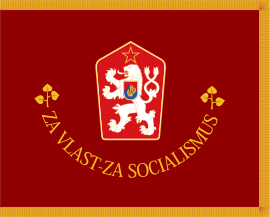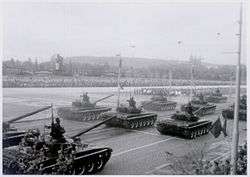Czechoslovak People's Army
The Czechoslovak People's Army (Czech: Československá lidová armáda, Slovak: Československá ľudová armáda, ČSLA) was the armed forces of the Communist Party of Czechoslovakia (KSC) and the Czechoslovak Socialist Republic from 1954[1] until 1990. From 1955 it was a member force of the Warsaw Pact. On 14 March 1990 the Army's name was reverted to the Czechoslovak Army removing the adjective "People's" from the name. The Czechoslovak Army was split into the Army of the Czech Republic and the Armed Forces of the Slovak Republic after the dissolution of Czechoslovakia on 1 January 1993.
| Czechoslovak People's Army | |
|---|---|
| Československá lidová armáda (ČSLA) Československá ľudová armáda (ČSĽA) | |
 Flag of the Czechoslovak People's Army (1960–1990) | |
| Motto | Za vlast–za socialismus Za vlasť–za socializmus (For Homeland–For Socialism) |
| Founded | 1 June 1954 |
| Disbanded | 14 March 1990 |
| Service branches |
|
| Headquarters | Prague, Czechoslovakia |
| Leadership | |
| President of Czechoslovakia | |
| Minister of Defence | See list
|
| Reaching military age annually | (201,000 (1987)) |
| Related articles | |
| Ranks | Ranks of the Czechoslovak Armed Forces |

Transition to Communist rule
On 25 May 1945 the Provisional organization of the Czechoslovak armed forces was approved, according to which there was a reorganization of the Czechoslovak army. Soldiers who had fought against Nazism on all fronts of World War II gradually returned. The territory of Czechoslovakia was divided into four military areas in which emerged gradually over 16 infantry divisions, which complemented the Tank Corps and Artillery Division. The Czechoslovak I Corps which had served under Soviet control became the 1st Czechoslovak Army, before becoming the 1st Military Area.[2] Initial optimism about the plans to rebuild the army was replaced by disillusionment, stemming from a broken post-war economy and the lack of human and material resources. The Czechoslovak Army after the war was commissioned to expel Germans and Hungarians, and was also involved in helping the national economy. In addition, units of the National Security Corps participated in the fighting against the Organisation of Ukrainian Nationalists.

After 1948, when the Communist Party of Czechoslovakia took power, there were significant changes in the military. More than half of the officers began to experience persecution as well as soldiers, and many were forced to leave. The political processes focused mainly on soldiers who fought in World War II in Western Europe, but paradoxically there was also persecution of soldiers fighting the war on the Eastern Front. The army came fully under the power of the Communist Party and in 1950 there was a major reorganization of the Soviet model, and the military areas were disbanded. In 1951 there was signed between Czechoslovakia and the Soviet Union the Agreement on the manner and terms of settlement for the supplied equipment and material provided by the USSR loan of almost 44 million rubles for the purchase of military equipment, especially aircraft and radars. There has been an increase in proliferation and increasing the number of servicemen of the army, which since 1953 reached over 300,000.
During the period of the Czechoslovak Socialist Republic, regular Victory Day Parades were held by the Czechoslovak People's Army in Letná. The first parade took place in 1951 and, since, they were held every five years on 9 May up until 1990. The parade also marked the Prague uprising. The last of these parades took place in 1985.[3][4] Kde domov můj (the Czechoslovakian national anthem) was performed by the massed bands on parade before being followed by the State Anthem of the Soviet Union. Parades were also held in Bratislava as well.
Components
The ČSLA was composed of Ground Forces, Air Forces and Air Defence Forces.
Ground Forces
Of the approximately 201,000 personnel on active duty in the ČSLA in 1987, about 145,000, or about 72 percent, served in the ground forces (commonly referred to as the army). About 100,000 of these were conscripts.[5] There were two military districts, Western and Eastern. A 1989 listing of forces shows two Czechoslovak armies in the west, the 1st Army at Příbram with one tank division and three motor rifle divisions, the 4th Army at Písek with two tank divisions and two motor rifle divisions. In the Eastern Military District, there were two tank divisions, the 13th and 14th, with a supervisory headquarters at Trenčín in the Slovak part of the country.[6]
Czechoslovak military doctrine prescribed large tank columns spearheading infantry assaults. While the armoured columns secured objectives, the infantry would provide close support with mortars, snipers, anti-tank guns and medium artillery. The majority of the soldiers in the Ground Forces were recruited through conscription, compulsory military service of 24 months for all males between 18 and 27.
Air Force
The Czechoslovak Air Force was fully equipped with supersonic jet fighters, attack helicopters, air defence systems and electronic tracking equipment.
Air Defence Forces
The Army's air defence (PVOS, Protivzdušná obrana státu) had anti-aircraft missile units, fighter interceptor aircraft and radar and direction-finding units, known, in accordance with Soviet terminology, as radio-technical units.
Characteristics
The final Report of the Commission of Inquiry of the Federal Assembly for clarification of events November 17, 1989 characterized the Czechoslovak People's Army as follows: "... the Czechoslovak Army, next to the SNB (the people's police force) and LM (the paramilitary workers militia), was understood as one of the direct power tools designed for control over society and for the immediate management of internal political problems; the Communist Party by means of a vast staff of the Main Political Administration (HPS) of ČSLA penetrated as far as into the lowest units and in this way virtually ensured its absolute influence on the Army."[7] During the Velvet Revolution, Communist Minister of National Defence Milan Václavík proposed to use the army against demonstrators, but his suggestion was not heeded.[7]
On of the official marches of the ČSLA was the March of the Submachine Gunners ("Pochod samopalníků") by Jan Fadrhons.
Equipment
Ground Forces
| Tanks | Origin | Type | Versions | In service | Notes |
|---|---|---|---|---|---|
| T-72 | Main battle tank | M, M1 | 700 | ||
| T-55 | Main battle tank | 1,908 | 1,277 (48% of all Czech tanks) in reserve status |
| APC/AFC | Origin | Type | Versions | In service | Notes |
|---|---|---|---|---|---|
| BVP-2 | IFV | 280 | |||
| BVP-1 | IFV | 1,390 | |||
| OT-90 | APC | 620 | |||
| OT-64 | APC | 1,600 | |||
| OT-62 TOPAS | APC | Czechoslovak version of BTR-50 | |||
| BRDM-2 | Reconnaissance/Patrol Vehicle | ||||
Air and Air Defence Forces
| Model | Origin | Type | Versions | In service | Notes |
|---|---|---|---|---|---|
| MiG-29 | Fighter | 20 | 18 Single-Seat, 2 Training | ||
| MiG-23 | Fighter | BN,MF,ML,U | 70 | ||
| MiG-21 | Fighter,Ground-Attack | 180+ | |||
| Su-25 | Ground-Attack | K,UBK | 38 | 36 Single-Seat, 2 Training | |
| Su-22 | Attack | M,UM | 57 | 49 Single-Seat, 8 Training | |
| Mi-24 | Attack Helicopter | D,V | 62 | 29 Mi-24D,2 Mi-24UD,31 Mi-24V | |
| Mi-17 | Transport | ||||
| L-39 | Training | C,ZA,V | 57+ | 24 L-39C,27 L-39ZA,6 L-39V | |
Ranks of the Czechoslovak People's Army
Enlisted and non-commissioned officers
- Vojín – Private, Airman
- Svobodník – Private First Class, Airman First Class
- Desátník – Corporal, Senior Airman
- Četař – Sergeant
- Rotný – Staff Sergeant
- Staršina – Platoon Sergeant, Flight sergeant (part of the rank system 1948–1959)
- Rotmistr – Sergeant First Class, Technical Sergeant
- Nadrotmistr – Master Sergeant
- Štábní rotmistr – First Sergeant
Warrant officers
- Podpraporčík – First Warrant Officer
- Praporčík – Warrant officer
- Nadpraporčík – Senior Warrant Officer
- Štábní praporčík – Chief Warrant Officer (abolished 1949)
Officers
- Podporučík – Sub-lieutenant
- Poručík – Second lieutenant
- Nadporučík – First lieutenant
- Kapitán – Captain
- Štábní kapitán – Senior Captain (abolished 1952)
- Major
- Podplukovník – Lieutenant colonel
- Plukovník – Colonel
- Brigádní generál – Brigade General (abolished 1950)
- Divizní generál – Divisional General (abolished 1950)
- Generálmajor – Major General
- Generálporučík – Lieutenant General
- Sborový generál – Corps General (abolished 1950)
- Generálplukovník – Colonel General
- Armádní generál – General of the Army
See also
- Army of the Czech Republic
- Armed Forces of the Slovak Republic
References
- Burian, Michal; Rýc, Jiří (2007). Historie spojovacího vojska [History of [Czechoslovak] Signal Corps] (in Czech). Prague: Ministerstvo obrany – Agentura vojenských informací a služeb. p. 148. ISBN 978-80-7278-414-1.
- Valka.cz, Vojenska-oblast-1 1945–1950, accessed July 2013.
- "Prague Experienced a Military Parade After 23 Years". Lidovky.cz (in Czech). 28 October 2008. Retrieved 10 August 2019.
- Adamičková, Naďa; Königová, Marie (21 September 2016). "A Spectacular Military Parade Should Roar Through Prague". Novinky.cz (in Czech). Retrieved 10 August 2019.
- Library of Congress Country Study: Czechoslovakia, Ground Forces, 1987
- Orbat.com, Warsaw Pact Order of Battle 1989 Archived 27 September 2011 at the Wayback Machine, accessed 2 June 2010
- Final report of the inquiry commission of the Federal Assembly to clarify the events of 17 November 1989, Part IV. – Czechoslovak People's Army, [cit. 28 October 2009]. Available online.
- Defense Intelligence Agency, National Intelligence Survey: Armed Forces, May 1974 (declassified in accordance with the Freedom of Information Act)
- Steven J. Zaloga and James Loop, Soviet Bloc Elite Forces, London: Osprey, 1985
- Rice, Condoleezza. The Soviet Union and the Czechoslovak Army, 1948-1983: Uncertain Allegiance. Princeton University Press, 2014.
External links
- ČSLA (Czechoslovak People's Army) (in Czech) – professional website dedicated to this former military
- Československá armáda (Czechoslovak Army) (in Czech) – website about Czechoslovak and Czech forces since 1918
- Weapons and Equipment of the Czechoslovak People's Army 1948–1989
- od ČSLA k AČR I.
- Czechoslovak Military Parade 1985